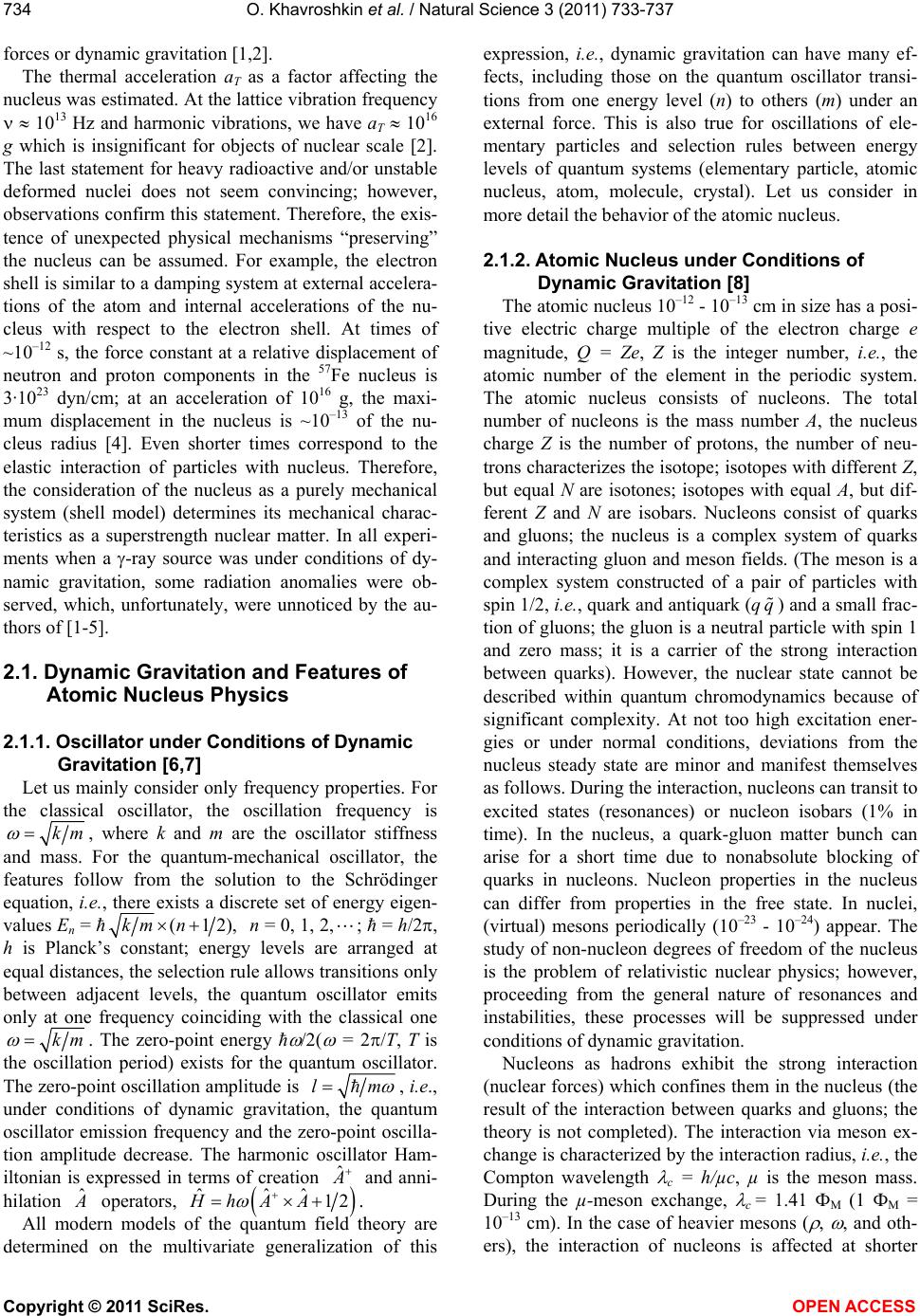
O. Khavroshkin et al. / Natural Science 3 (2011) 733-737
Copyright © 2011 SciRes. OPEN ACCESS
734
forces or dynamic gravitation [1,2].
The thermal acceleration aT as a factor affecting the
nucleus was estimated. At the lattice vibration frequency
1013 Hz and harmonic vibrations, we have aT 1016
g which is insignificant for objects of nuclear scale [2].
The last statement for heavy radioactive and/or unstable
deformed nuclei does not seem convincing; however,
observations confirm this statement. Therefore, the exis-
tence of unexpected physical mechanisms “preserving”
the nucleus can be assumed. For example, the electron
shell is similar to a damping system at external accelera-
tions of the atom and internal accelerations of the nu-
cleus with respect to the electron shell. At times of
~10–12 s, the force constant at a relative displacement of
neutron and proton components in the 57Fe nucleus is
3·1023 dyn/cm; at an acceleration of 1016 g, the maxi-
mum displacement in the nucleus is ~10–13 of the nu-
cleus radius [4]. Even shorter times correspond to the
elastic interaction of particles with nucleus. Therefore,
the consideration of the nucleus as a purely mechanical
system (shell model) determines its mechanical charac-
teristics as a superstrength nuclear matter. In all experi-
ments when a -ray source was under conditions of dy-
namic gravitation, some radiation anomalies were ob-
served, which, unfortunately, were unnoticed by the au-
thors of [1-5].
2.1. Dynamic Gravitation and Features of
Atomic Nucleus Physics
2.1.1. Oscillator under Conditions of Dynamic
Gravitation [6,7]
Let us mainly consider only frequency properties. For
the classical oscillator, the oscillation frequency is
km
, where k and m are the oscillator stiffness
and mass. For the quantum-mechanical oscillator, the
features follow from the solution to the Schrödinger
equation, i.e., there exists a discrete set of energy eigen-
values En = ħ(12),km n n = 0, 1, 2,; ħ = h/2,
h is Planck’s constant; energy levels are arranged at
equal distances, the selection rule allows transitions only
between adjacent levels, the quantum oscillator emits
only at one frequency coinciding with the classical one
km
. The zero-point energy ħ
/2(
= 2/T, Т is
the oscillation period) exists for the quantum oscillator.
The zero-point oscillation amplitude is lm
, i.e.,
under conditions of dynamic gravitation, the quantum
oscillator emission frequency and the zero-point oscilla-
tion amplitude decrease. The harmonic oscillator Ham-
iltonian is expressed in terms of creation ˆ
and anni-
hilation ˆ
operators,
ˆˆ
ˆ12HhA A
.
All modern models of the quantum field theory are
determined on the multivariate generalization of this
expression, i.e., dynamic gravitation can have many ef-
fects, including those on the quantum oscillator transi-
tions from one energy level (n) to others (m) under an
external force. This is also true for oscillations of ele-
mentary particles and selection rules between energy
levels of quantum systems (elementary particle, atomic
nucleus, atom, molecule, crystal). Let us consider in
more detail the behavior of the atomic nucleus.
2.1.2. Atomic Nucleus under Conditions of
Dynamic Gravitation [8]
The atomic nucleus 10–12 - 10–13 cm in size has a posi-
tive electric charge multiple of the electron charge e
magnitude, Q = Ze, Z is the integer number, i.e., the
atomic number of the element in the periodic system.
The atomic nucleus consists of nucleons. The total
number of nucleons is the mass number A, the nucleus
charge Z is the number of protons, the number of neu-
trons characterizes the isotope; isotopes with different Z,
but equal N are isotones; isotopes with equal A, but dif-
ferent Z and N are isobars. Nucleons consist of quarks
and gluons; the nucleus is a complex system of quarks
and interacting gluon and meson fields. (The meson is a
complex system constructed of a pair of particles with
spin 1/2, i.e., quark and antiquark (qq
) and a small frac-
tion of gluons; the gluon is a neutral particle with spin 1
and zero mass; it is a carrier of the strong interaction
between quarks). However, the nuclear state cannot be
described within quantum chromodynamics because of
significant complexity. At not too high excitation ener-
gies or under normal conditions, deviations from the
nucleus steady state are minor and manifest themselves
as follows. During the interaction, nucleons can transit to
excited states (resonances) or nucleon isobars (1% in
time). In the nucleus, a quark-gluon matter bunch can
arise for a short time due to nonabsolute blocking of
quarks in nucleons. Nucleon properties in the nucleus
can differ from properties in the free state. In nuclei,
(virtual) mesons periodically (10–23 - 10–24) appear. The
study of non-nucleon degrees of freedom of the nucleus
is the problem of relativistic nuclear physics; however,
proceeding from the general nature of resonances and
instabilities, these processes will be suppressed under
conditions of dynamic gravitation.
Nucleons as hadrons exhibit the strong interaction
(nuclear forces) which confines them in the nucleus (the
result of the interaction between quarks and gluons; the
theory is not completed). The interaction via meson ex-
change is characterized by the interaction radius, i.e., the
Compton wavelength
с = h/µc, µ is the meson mass.
During the µ-meson exchange,
с = 1.41 ФМ (1 ФМ =
10–13 cm). In the case of heavier mesons (
,
, and oth-
ers), the interaction of nucleons is affected at shorter